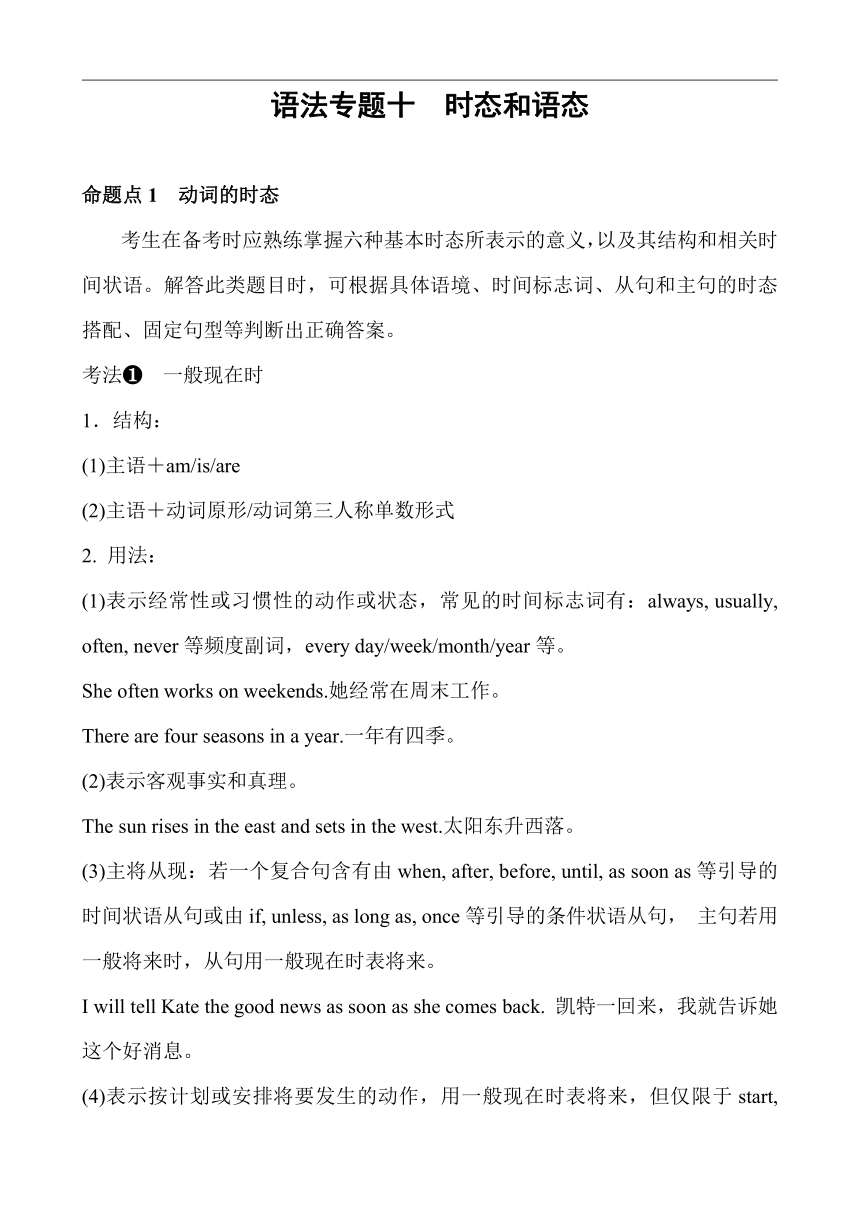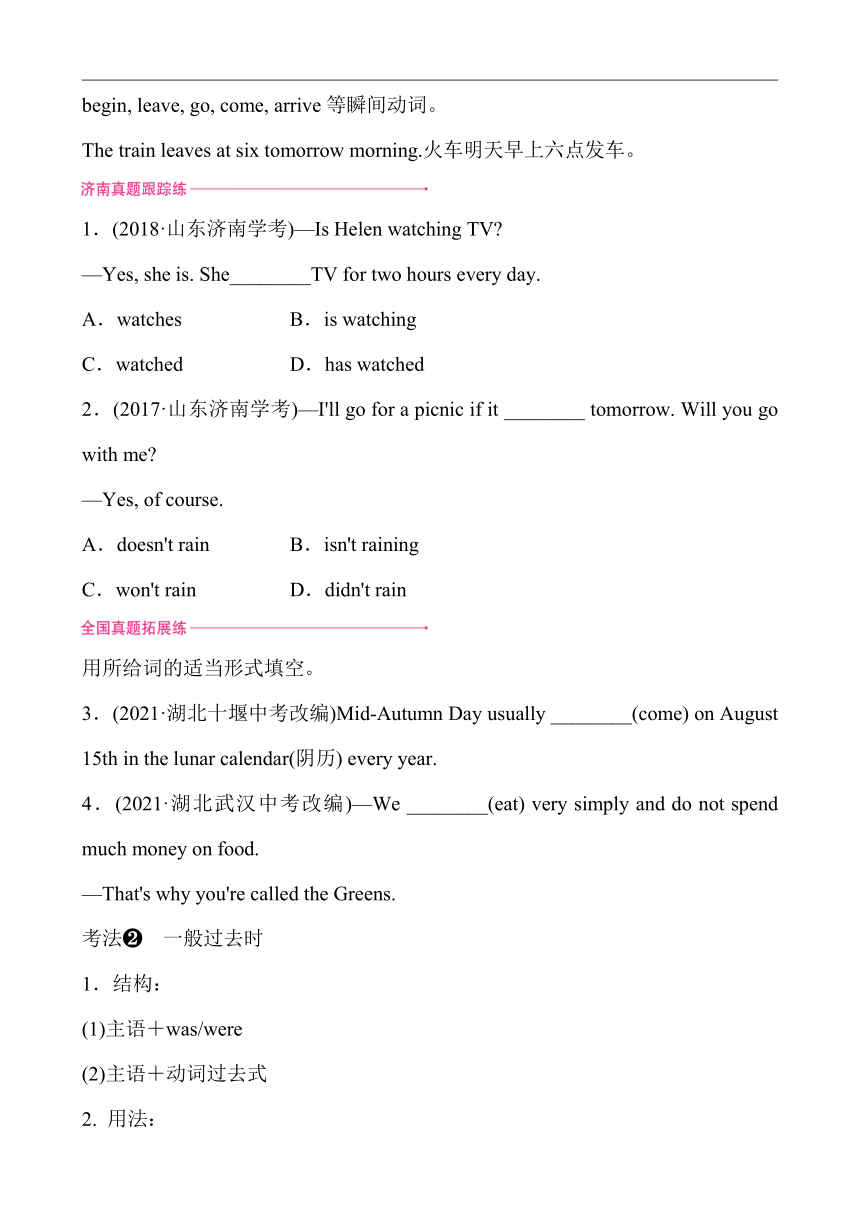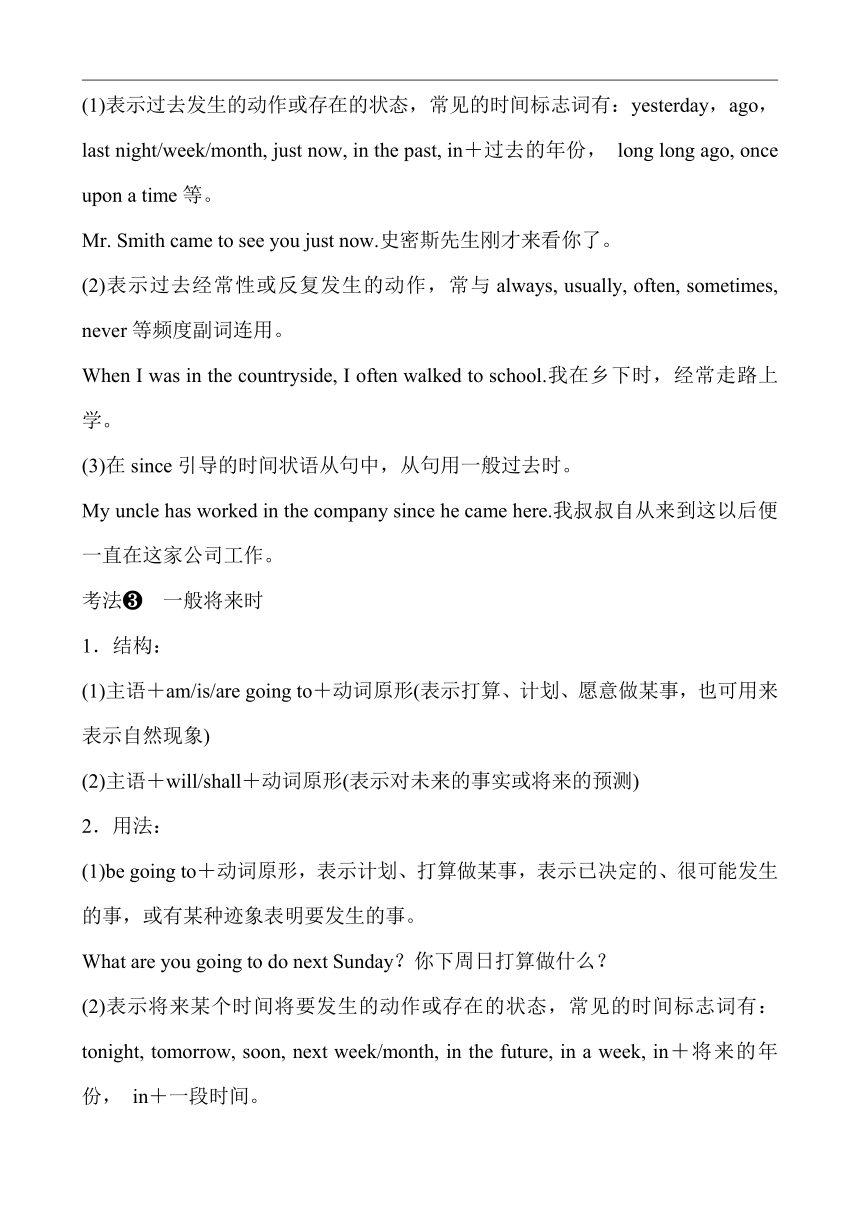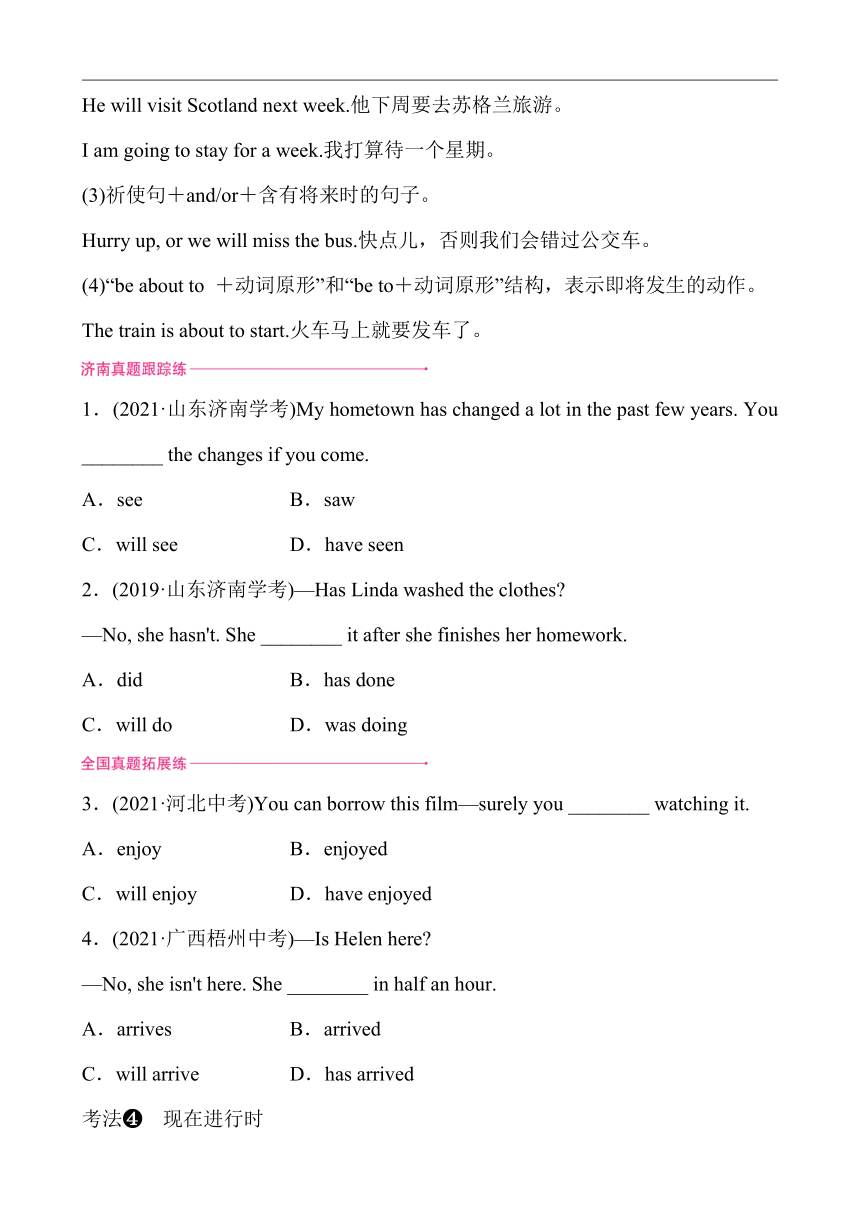2022中考初中英语 二轮 语法专题十 时态和语态 (含答案)
文档属性
| 名称 | 2022中考初中英语 二轮 语法专题十 时态和语态 (含答案) |  | |
| 格式 | doc | ||
| 文件大小 | 3.9MB | ||
| 资源类型 | 教案 | ||
| 版本资源 | 通用版 | ||
| 科目 | 英语 | ||
| 更新时间 | 2022-03-22 23:00:27 | ||
图片预览





文档简介
语法专题十 时态和语态
命题点1 动词的时态
考生在备考时应熟练掌握六种基本时态所表示的意义,以及其结构和相关时间状语。解答此类题目时,可根据具体语境、时间标志词、从句和主句的时态搭配、固定句型等判断出正确答案。
考法 一般现在时
1.结构:
(1)主语+am/is/are
(2)主语+动词原形/动词第三人称单数形式
2. 用法:
(1)表示经常性或习惯性的动作或状态,常见的时间标志词有:always, usually, often, never等频度副词,every day/week/month/year等。
She often works on weekends.她经常在周末工作。
There are four seasons in a year.一年有四季。
(2)表示客观事实和真理。
The sun rises in the east and sets in the west.太阳东升西落。
(3)主将从现:若一个复合句含有由when, after, before, until, as soon as等引导的时间状语从句或由if, unless, as long as, once等引导的条件状语从句, 主句若用一般将来时,从句用一般现在时表将来。
I will tell Kate the good news as soon as she comes back. 凯特一回来,我就告诉她这个好消息。
(4)表示按计划或安排将要发生的动作,用一般现在时表将来,但仅限于start, begin, leave, go, come, arrive等瞬间动词。
The train leaves at six tomorrow morning.火车明天早上六点发车。
INCLUDEPICTURE"图标-济南真题-跟踪练.TIF" INCLUDEPICTURE "图标-济南真题-跟踪练.TIF" \* MERGEFORMAT
1.(2018·山东济南学考)—Is Helen watching TV
—Yes, she is. She________TV for two hours every day.
A.watches B.is watching
C.watched D.has watched
2.(2017·山东济南学考)—I'll go for a picnic if it ________ tomorrow. Will you go with me
—Yes, of course.
A.doesn't rain B.isn't raining
C.won't rain D.didn't rain
INCLUDEPICTURE"图标-全国真题-拓展练.TIF" INCLUDEPICTURE "图标-全国真题-拓展练.TIF" \* MERGEFORMAT
用所给词的适当形式填空。
3.(2021·湖北十堰中考改编)Mid Autumn Day usually ________(come) on August 15th in the lunar calendar(阴历) every year.
4.(2021·湖北武汉中考改编)—We ________(eat) very simply and do not spend much money on food.
—That's why you're called the Greens.
考法 一般过去时
1.结构:
(1)主语+was/were
(2)主语+动词过去式
2. 用法:
(1)表示过去发生的动作或存在的状态,常见的时间标志词有:yesterday,ago,last night/week/month, just now, in the past, in+过去的年份, long long ago, once upon a time等。
Mr. Smith came to see you just now.史密斯先生刚才来看你了。
(2)表示过去经常性或反复发生的动作,常与always, usually, often, sometimes, never等频度副词连用。
When I was in the countryside, I often walked to school.我在乡下时,经常走路上学。
(3)在since引导的时间状语从句中,从句用一般过去时。
My uncle has worked in the company since he came here.我叔叔自从来到这以后便一直在这家公司工作。
考法 一般将来时
1.结构:
(1)主语+am/is/are going to+动词原形(表示打算、计划、愿意做某事,也可用来表示自然现象)
(2)主语+will/shall+动词原形(表示对未来的事实或将来的预测)
2.用法:
(1)be going to+动词原形,表示计划、打算做某事,表示已决定的、很可能发生的事,或有某种迹象表明要发生的事。
What are you going to do next Sunday?你下周日打算做什么?
(2)表示将来某个时间将要发生的动作或存在的状态,常见的时间标志词有:tonight, tomorrow, soon, next week/month, in the future, in a week, in+将来的年份, in+一段时间。
He will visit Scotland next week.他下周要去苏格兰旅游。
I am going to stay for a week.我打算待一个星期。
(3)祈使句+and/or+含有将来时的句子。
Hurry up, or we will miss the bus.快点儿,否则我们会错过公交车。
(4)“be about to +动词原形”和“be to+动词原形”结构,表示即将发生的动作。
The train is about to start.火车马上就要发车了。
INCLUDEPICTURE"图标-济南真题-跟踪练.TIF" INCLUDEPICTURE "图标-济南真题-跟踪练.TIF" \* MERGEFORMAT
1.(2021·山东济南学考)My hometown has changed a lot in the past few years. You ________ the changes if you come.
A.see B.saw
C.will see D.have seen
2.(2019·山东济南学考)—Has Linda washed the clothes
—No, she hasn't. She ________ it after she finishes her homework.
A.did B.has done
C.will do D.was doing
INCLUDEPICTURE"图标-全国真题-拓展练.TIF" INCLUDEPICTURE "图标-全国真题-拓展练.TIF" \* MERGEFORMAT
3.(2021·河北中考)You can borrow this film—surely you ________ watching it.
A.enjoy B.enjoyed
C.will enjoy D.have enjoyed
4.(2021·广西梧州中考)—Is Helen here
—No, she isn't here. She ________ in half an hour.
A.arrives B.arrived
C.will arrive D.has arrived
考法 现在进行时
1.结构:am/is/are+动词现在分词
2. 用法:
(1)表示此刻正在发生的动作,常见的时间标志词有:now, at the moment, these days, right now等,也常与“Look!”“Listen!”等连用。
Look! A bird is flying in the sky.看!一只鸟在天上飞。
(2)表示现阶段一直在进行的动作,此刻不一定在进行,常用时间状语有:this/these+表示一段时间的名词。
All the students in Class Three are studying hard this term. 三班的所有学生这学期学习都很努力。
(3)be doing表示将来,常用于这种结构的动词有come, go, leave, arrive, start, begin等,表示即将发生或安排好要做的事情。
The train is leaving in ten minutes.列车定于十分钟后开车。
考法 过去进行时
1.结构:主语+was/were+动词现在分词
2. 用法:
(1)表示过去某一时刻或过去一段时间内正在进行的动作。常见的时间标志词有:at that time, at this time yesterday, at 1:00 last night, at that moment, then等。
She was watching TV at this time yesterday.昨天这个时候她正在看电视。
(2)表示过去某段时间内持续进行的动作。
They were waiting for you last night.昨晚他们一直在等你。
(3)过去进行时常和always 等频度副词连用,表示过去频繁发生的动作,此时的过去进行时带有一定的感彩。
Alice was always changing her mind.艾丽斯总是改变主意。(表示厌烦)
(4)在含有when或while引导的时间状语从句中,过去进行时的运用:
①在when引导的时间状语从句中,从句用一般过去时,主句用过去进行时,表示一个动作发生时,另一个动作正在进行。
When he called me, I was having dinner.当他给我打电话时,我正在吃晚饭。
②在while引导的时间状语从句中,主句与从句均用过去进行时,表示动作在过去某一时刻同时进行,while意为“当……的时候,同时”。
I was doing my homework while my sister was watching TV.当我的妹妹在看电视时,我在做作业。
INCLUDEPICTURE"图标-济南真题-跟踪练.TIF" INCLUDEPICTURE "图标-济南真题-跟踪练.TIF" \* MERGEFORMAT
1.(2016·山东济南学考)Sun Hai ________ his mother make dinner when his father got home from work.
A.was helping B.helps
C.helped D.is helping
INCLUDEPICTURE"图标-全国真题-拓展练.TIF" INCLUDEPICTURE "图标-全国真题-拓展练.TIF" \* MERGEFORMAT
2.(2021·四川遂宁中考)—I ________ when you called me at 8:00 last night.
—No wonder you didn't pick it up.
A.was taking a shower B.am taking a shower
C.took a shower D.take a shower
用所给词的适当形式填空。
3.(2021·湖北黄石中考改编)—What were you doing at the time of the rainstorm yesterday
—I ________(read) at the library after school.
4.(2021·内蒙古包头中考改编)—Did you see Dorothy She just came back from abroad.
—Yes. But she ________(phone) someone, so I nodded to her and went away.
考法 现在完成时
1.结构:主语+has/have+动词过去分词
2.用法:
(1)表示过去发生的动作或已经完成的动作对现在造成的影响,常见的时间标志词有:already, yet, before, just, ever, never, so far, recently, in the past/last five years, since, for+时间段等。
They have lost the match.他们已经输了比赛。
(2)表示从过去开始延续到现在的动作或状态,也许还要持续下去,且含有表示一段时间的时间状语,谓语动词应用延续性动词;如果动词是非延续性动词,要将非延续性动词转化为延续性动词。常见转化见下表:
非延续性动词/短语 延续性动词/短语
die be dead
marry be married
begin/start be on
buy have
leave be away from
open be open
borrow/lend keep
join be in/be a member of
arrive in/at/reach/get to be in
catch a cold have a cold
come back be back
fall/become asleep/ill be asleep/ill
I've left this school for eight years.(误)
I've been away from this school for eight years.(正)
(3)辨析have gone to,have been to 与 have been in
短语 含义及用法
have gone to 表示“去了(某地)”,强调去了,还未回来
have been to 表示“去过(某地)”,强调去过,已经回来,常与次数或never连用
have been in 表示“在……待……”,强调一直待在某地,常与表示一段时间的时间状语连用
Mary has gone to Hong Kong.玛丽去香港了。(现在还没回来)
Mary has been to Hong Kong twice.玛丽已经去过香港两次了。(现在已经回来)
Mary has been in Hong Kong for two years. 玛丽已经在香港待了两年了。
INCLUDEPICTURE"图标-济南真题-跟踪练.TIF" INCLUDEPICTURE "图标-济南真题-跟踪练.TIF" \* MERGEFORMAT
1.(2017·山东济南学考)—Oh, no! We are too late. The train ________.
—Well, we'll have to catch the next train to Beijing.
A.leaves B.left
C.will leave D.has left
2.(2016·山东济南学考)—I think our teacher, Mrs. Allen, knows everything.
—I agree. Because she ________ over 2,000 books.
A.read B.has read
C.reads D.is reading
INCLUDEPICTURE"图标-全国真题-拓展练.TIF" INCLUDEPICTURE "图标-全国真题-拓展练.TIF" \* MERGEFORMAT
3.(2021·湖北鄂州中考)—Would you like something to drink
—No, thanks. I ________ some tea already.
A.have drunk B.was drinking
C.will drink D.drink
4.(2021·广西玉林中考)Hey! Kate, what about your last winter camp in Hainan
—Oh! It ________ some sweet memories in my heart in the past several months.
A.leaves B.is leaving
C.has left D.will leave
5.(2021·广西贺州中考)China ________ great achievements in science and technology since 1978.
A.makes B.made
C.has made D.is made
6.(2021·江苏南京中考)I saw Julia in April and I ________ her since then.
A.don't see B.didn't see
C.won't see D.haven't seen
命题点2 被动语态
在解答此类题目时,考生首先应判断题目是否考查被动语态,有两种方法:
①根据被动语态的基本结构来判断,若动作的承受者(动作的对象,多是名词或代词)在空前,实施者在空后(有时也省略),则用被动语态;②根据主语和谓语之间的逻辑关系来判断,若主语与谓语之间构成逻辑上的动宾关系,则用被动语态。
其次,根据语境、给出的时间状语或已经发生动作的时态来确定正确的时态。
最后,根据被动语态的结构,填写动词的正确形式。
1.被动语态的构成
(1)一般现在时
结构:am/is/are done
This machine is made in China.这台机器是中国制造的。
(2)一般过去时
结构:was/were done
The windows in our classroom were broken yesterday.
昨天我们教室的窗户被打碎了。
(3)一般将来时
结构:will/shall/be going to be done
I think the desks will be repaired soon.我想这些课桌很快要被修好了。
(4)含情态动词
结构:情态动词+be done
Where can the lost book be found?这本丢失的书能在哪里找到?
Waste paper shouldn't be thrown here.废纸不应该被扔在这儿。
2.主动语态变被动语态的方法
INCLUDEPICTURE"21AHRYY2.TIF" INCLUDEPICTURE "21AHRYY2.TIF" \* MERGEFORMAT
口诀:宾变主,主变宾,谓语动词用被动。
【命题专家点拨】
常见主动语态变被动语态的特殊情况
主动语态中有些感官动词(如hear,see,watch,notice等)和使役动词(如make,let等)后用不带to的不定式作宾语补足语,变为被动语态时,要把不定式符号to还原。例如:
hear/see sb. do sth.→sb. be heard/seen to do sth.make sb. do sth.→sb. be made to do sth.
3.使用被动语态的情况
(1)不知道动作的执行者是谁。
Rice is grown in the south of China. 中国南方种植水稻。
(2)没有必要指出动作的执行者。
Smoking isn't allowed in the gas station.加油站里不允许吸烟。
(3)需要强调和突出动作的承受者。
Your work must be finished today.你(们)的工作今天必须完成。
(4)句子的主语是物。
Many houses were washed away by the flood.许多房屋被洪水冲走了。
4.主动结构表被动意义的情况
(1)open, lock, write, read, sell, clean, watch, cut, burn, drive等作不及物动词时,当它们的主语为物时,可用主动结构表被动意义。
This kind of pen writes very smoothly.这种钢笔写起来很流畅。
(2)look, sound, taste, smell等感官动词用主动结构表被动意义。
Mooncakes taste very delicious.月饼尝起来很好吃。
(3)be worth doing用主动形式表被动意义。
This book is worth reading.这本书值得一读。
(4)want/need/require+doing相当于want/need/require+to be done。to be done为不定式的被动结构。
Your car needs washing.=Your car needs to be washed.你的汽车需要清洗了。
INCLUDEPICTURE"图标-济南真题-跟踪练.TIF" INCLUDEPICTURE "图标-济南真题-跟踪练.TIF" \* MERGEFORMAT
1.(2020·山东济南学考)The Tokyo 2020 Olympics ________ because of COVID 19 a few months ago.
A.were put off B.will put off
C.are putting off D.are put off
INCLUDEPICTURE"图标-全国真题-拓展练.TIF" INCLUDEPICTURE "图标-全国真题-拓展练.TIF" \* MERGEFORMAT
2.(2021·四川遂宁中考)To celebrate the 100th birthday of the Communist Party of China, a speech competition ________ in our school last week.
A.hold B.held
C.is held D.was held
3.(2021·湖北十堰中考)Fishing ________ in order to protect the ecosystem of Hanjiang River.
A.allows B.is allowed
C.isn't allowed D.won't allow
用所给词的适当形式填空。
4.(2021·江苏盐城中考改编)Rainbows ________(produce) when sunlight passes through small drops of water in the sky.
5.(2021·江苏南京中考改编)Our school library ________(decorate) with plants, lovely desks and chairs, so I feel relaxed while studying or reading there.
参考答案
【命题点1】
考法1 1~2 AA 3.comes 4.eat
考法3 1~4 CCCC
考法5 1~2 AA 3.was reading 4.was phoning
考法6 1~6 DBACCD
【命题点2】
1~3 ADC 4.are produced 5.is decorated
命题点1 动词的时态
考生在备考时应熟练掌握六种基本时态所表示的意义,以及其结构和相关时间状语。解答此类题目时,可根据具体语境、时间标志词、从句和主句的时态搭配、固定句型等判断出正确答案。
考法 一般现在时
1.结构:
(1)主语+am/is/are
(2)主语+动词原形/动词第三人称单数形式
2. 用法:
(1)表示经常性或习惯性的动作或状态,常见的时间标志词有:always, usually, often, never等频度副词,every day/week/month/year等。
She often works on weekends.她经常在周末工作。
There are four seasons in a year.一年有四季。
(2)表示客观事实和真理。
The sun rises in the east and sets in the west.太阳东升西落。
(3)主将从现:若一个复合句含有由when, after, before, until, as soon as等引导的时间状语从句或由if, unless, as long as, once等引导的条件状语从句, 主句若用一般将来时,从句用一般现在时表将来。
I will tell Kate the good news as soon as she comes back. 凯特一回来,我就告诉她这个好消息。
(4)表示按计划或安排将要发生的动作,用一般现在时表将来,但仅限于start, begin, leave, go, come, arrive等瞬间动词。
The train leaves at six tomorrow morning.火车明天早上六点发车。
INCLUDEPICTURE"图标-济南真题-跟踪练.TIF" INCLUDEPICTURE "图标-济南真题-跟踪练.TIF" \* MERGEFORMAT
1.(2018·山东济南学考)—Is Helen watching TV
—Yes, she is. She________TV for two hours every day.
A.watches B.is watching
C.watched D.has watched
2.(2017·山东济南学考)—I'll go for a picnic if it ________ tomorrow. Will you go with me
—Yes, of course.
A.doesn't rain B.isn't raining
C.won't rain D.didn't rain
INCLUDEPICTURE"图标-全国真题-拓展练.TIF" INCLUDEPICTURE "图标-全国真题-拓展练.TIF" \* MERGEFORMAT
用所给词的适当形式填空。
3.(2021·湖北十堰中考改编)Mid Autumn Day usually ________(come) on August 15th in the lunar calendar(阴历) every year.
4.(2021·湖北武汉中考改编)—We ________(eat) very simply and do not spend much money on food.
—That's why you're called the Greens.
考法 一般过去时
1.结构:
(1)主语+was/were
(2)主语+动词过去式
2. 用法:
(1)表示过去发生的动作或存在的状态,常见的时间标志词有:yesterday,ago,last night/week/month, just now, in the past, in+过去的年份, long long ago, once upon a time等。
Mr. Smith came to see you just now.史密斯先生刚才来看你了。
(2)表示过去经常性或反复发生的动作,常与always, usually, often, sometimes, never等频度副词连用。
When I was in the countryside, I often walked to school.我在乡下时,经常走路上学。
(3)在since引导的时间状语从句中,从句用一般过去时。
My uncle has worked in the company since he came here.我叔叔自从来到这以后便一直在这家公司工作。
考法 一般将来时
1.结构:
(1)主语+am/is/are going to+动词原形(表示打算、计划、愿意做某事,也可用来表示自然现象)
(2)主语+will/shall+动词原形(表示对未来的事实或将来的预测)
2.用法:
(1)be going to+动词原形,表示计划、打算做某事,表示已决定的、很可能发生的事,或有某种迹象表明要发生的事。
What are you going to do next Sunday?你下周日打算做什么?
(2)表示将来某个时间将要发生的动作或存在的状态,常见的时间标志词有:tonight, tomorrow, soon, next week/month, in the future, in a week, in+将来的年份, in+一段时间。
He will visit Scotland next week.他下周要去苏格兰旅游。
I am going to stay for a week.我打算待一个星期。
(3)祈使句+and/or+含有将来时的句子。
Hurry up, or we will miss the bus.快点儿,否则我们会错过公交车。
(4)“be about to +动词原形”和“be to+动词原形”结构,表示即将发生的动作。
The train is about to start.火车马上就要发车了。
INCLUDEPICTURE"图标-济南真题-跟踪练.TIF" INCLUDEPICTURE "图标-济南真题-跟踪练.TIF" \* MERGEFORMAT
1.(2021·山东济南学考)My hometown has changed a lot in the past few years. You ________ the changes if you come.
A.see B.saw
C.will see D.have seen
2.(2019·山东济南学考)—Has Linda washed the clothes
—No, she hasn't. She ________ it after she finishes her homework.
A.did B.has done
C.will do D.was doing
INCLUDEPICTURE"图标-全国真题-拓展练.TIF" INCLUDEPICTURE "图标-全国真题-拓展练.TIF" \* MERGEFORMAT
3.(2021·河北中考)You can borrow this film—surely you ________ watching it.
A.enjoy B.enjoyed
C.will enjoy D.have enjoyed
4.(2021·广西梧州中考)—Is Helen here
—No, she isn't here. She ________ in half an hour.
A.arrives B.arrived
C.will arrive D.has arrived
考法 现在进行时
1.结构:am/is/are+动词现在分词
2. 用法:
(1)表示此刻正在发生的动作,常见的时间标志词有:now, at the moment, these days, right now等,也常与“Look!”“Listen!”等连用。
Look! A bird is flying in the sky.看!一只鸟在天上飞。
(2)表示现阶段一直在进行的动作,此刻不一定在进行,常用时间状语有:this/these+表示一段时间的名词。
All the students in Class Three are studying hard this term. 三班的所有学生这学期学习都很努力。
(3)be doing表示将来,常用于这种结构的动词有come, go, leave, arrive, start, begin等,表示即将发生或安排好要做的事情。
The train is leaving in ten minutes.列车定于十分钟后开车。
考法 过去进行时
1.结构:主语+was/were+动词现在分词
2. 用法:
(1)表示过去某一时刻或过去一段时间内正在进行的动作。常见的时间标志词有:at that time, at this time yesterday, at 1:00 last night, at that moment, then等。
She was watching TV at this time yesterday.昨天这个时候她正在看电视。
(2)表示过去某段时间内持续进行的动作。
They were waiting for you last night.昨晚他们一直在等你。
(3)过去进行时常和always 等频度副词连用,表示过去频繁发生的动作,此时的过去进行时带有一定的感彩。
Alice was always changing her mind.艾丽斯总是改变主意。(表示厌烦)
(4)在含有when或while引导的时间状语从句中,过去进行时的运用:
①在when引导的时间状语从句中,从句用一般过去时,主句用过去进行时,表示一个动作发生时,另一个动作正在进行。
When he called me, I was having dinner.当他给我打电话时,我正在吃晚饭。
②在while引导的时间状语从句中,主句与从句均用过去进行时,表示动作在过去某一时刻同时进行,while意为“当……的时候,同时”。
I was doing my homework while my sister was watching TV.当我的妹妹在看电视时,我在做作业。
INCLUDEPICTURE"图标-济南真题-跟踪练.TIF" INCLUDEPICTURE "图标-济南真题-跟踪练.TIF" \* MERGEFORMAT
1.(2016·山东济南学考)Sun Hai ________ his mother make dinner when his father got home from work.
A.was helping B.helps
C.helped D.is helping
INCLUDEPICTURE"图标-全国真题-拓展练.TIF" INCLUDEPICTURE "图标-全国真题-拓展练.TIF" \* MERGEFORMAT
2.(2021·四川遂宁中考)—I ________ when you called me at 8:00 last night.
—No wonder you didn't pick it up.
A.was taking a shower B.am taking a shower
C.took a shower D.take a shower
用所给词的适当形式填空。
3.(2021·湖北黄石中考改编)—What were you doing at the time of the rainstorm yesterday
—I ________(read) at the library after school.
4.(2021·内蒙古包头中考改编)—Did you see Dorothy She just came back from abroad.
—Yes. But she ________(phone) someone, so I nodded to her and went away.
考法 现在完成时
1.结构:主语+has/have+动词过去分词
2.用法:
(1)表示过去发生的动作或已经完成的动作对现在造成的影响,常见的时间标志词有:already, yet, before, just, ever, never, so far, recently, in the past/last five years, since, for+时间段等。
They have lost the match.他们已经输了比赛。
(2)表示从过去开始延续到现在的动作或状态,也许还要持续下去,且含有表示一段时间的时间状语,谓语动词应用延续性动词;如果动词是非延续性动词,要将非延续性动词转化为延续性动词。常见转化见下表:
非延续性动词/短语 延续性动词/短语
die be dead
marry be married
begin/start be on
buy have
leave be away from
open be open
borrow/lend keep
join be in/be a member of
arrive in/at/reach/get to be in
catch a cold have a cold
come back be back
fall/become asleep/ill be asleep/ill
I've left this school for eight years.(误)
I've been away from this school for eight years.(正)
(3)辨析have gone to,have been to 与 have been in
短语 含义及用法
have gone to 表示“去了(某地)”,强调去了,还未回来
have been to 表示“去过(某地)”,强调去过,已经回来,常与次数或never连用
have been in 表示“在……待……”,强调一直待在某地,常与表示一段时间的时间状语连用
Mary has gone to Hong Kong.玛丽去香港了。(现在还没回来)
Mary has been to Hong Kong twice.玛丽已经去过香港两次了。(现在已经回来)
Mary has been in Hong Kong for two years. 玛丽已经在香港待了两年了。
INCLUDEPICTURE"图标-济南真题-跟踪练.TIF" INCLUDEPICTURE "图标-济南真题-跟踪练.TIF" \* MERGEFORMAT
1.(2017·山东济南学考)—Oh, no! We are too late. The train ________.
—Well, we'll have to catch the next train to Beijing.
A.leaves B.left
C.will leave D.has left
2.(2016·山东济南学考)—I think our teacher, Mrs. Allen, knows everything.
—I agree. Because she ________ over 2,000 books.
A.read B.has read
C.reads D.is reading
INCLUDEPICTURE"图标-全国真题-拓展练.TIF" INCLUDEPICTURE "图标-全国真题-拓展练.TIF" \* MERGEFORMAT
3.(2021·湖北鄂州中考)—Would you like something to drink
—No, thanks. I ________ some tea already.
A.have drunk B.was drinking
C.will drink D.drink
4.(2021·广西玉林中考)Hey! Kate, what about your last winter camp in Hainan
—Oh! It ________ some sweet memories in my heart in the past several months.
A.leaves B.is leaving
C.has left D.will leave
5.(2021·广西贺州中考)China ________ great achievements in science and technology since 1978.
A.makes B.made
C.has made D.is made
6.(2021·江苏南京中考)I saw Julia in April and I ________ her since then.
A.don't see B.didn't see
C.won't see D.haven't seen
命题点2 被动语态
在解答此类题目时,考生首先应判断题目是否考查被动语态,有两种方法:
①根据被动语态的基本结构来判断,若动作的承受者(动作的对象,多是名词或代词)在空前,实施者在空后(有时也省略),则用被动语态;②根据主语和谓语之间的逻辑关系来判断,若主语与谓语之间构成逻辑上的动宾关系,则用被动语态。
其次,根据语境、给出的时间状语或已经发生动作的时态来确定正确的时态。
最后,根据被动语态的结构,填写动词的正确形式。
1.被动语态的构成
(1)一般现在时
结构:am/is/are done
This machine is made in China.这台机器是中国制造的。
(2)一般过去时
结构:was/were done
The windows in our classroom were broken yesterday.
昨天我们教室的窗户被打碎了。
(3)一般将来时
结构:will/shall/be going to be done
I think the desks will be repaired soon.我想这些课桌很快要被修好了。
(4)含情态动词
结构:情态动词+be done
Where can the lost book be found?这本丢失的书能在哪里找到?
Waste paper shouldn't be thrown here.废纸不应该被扔在这儿。
2.主动语态变被动语态的方法
INCLUDEPICTURE"21AHRYY2.TIF" INCLUDEPICTURE "21AHRYY2.TIF" \* MERGEFORMAT
口诀:宾变主,主变宾,谓语动词用被动。
【命题专家点拨】
常见主动语态变被动语态的特殊情况
主动语态中有些感官动词(如hear,see,watch,notice等)和使役动词(如make,let等)后用不带to的不定式作宾语补足语,变为被动语态时,要把不定式符号to还原。例如:
hear/see sb. do sth.→sb. be heard/seen to do sth.make sb. do sth.→sb. be made to do sth.
3.使用被动语态的情况
(1)不知道动作的执行者是谁。
Rice is grown in the south of China. 中国南方种植水稻。
(2)没有必要指出动作的执行者。
Smoking isn't allowed in the gas station.加油站里不允许吸烟。
(3)需要强调和突出动作的承受者。
Your work must be finished today.你(们)的工作今天必须完成。
(4)句子的主语是物。
Many houses were washed away by the flood.许多房屋被洪水冲走了。
4.主动结构表被动意义的情况
(1)open, lock, write, read, sell, clean, watch, cut, burn, drive等作不及物动词时,当它们的主语为物时,可用主动结构表被动意义。
This kind of pen writes very smoothly.这种钢笔写起来很流畅。
(2)look, sound, taste, smell等感官动词用主动结构表被动意义。
Mooncakes taste very delicious.月饼尝起来很好吃。
(3)be worth doing用主动形式表被动意义。
This book is worth reading.这本书值得一读。
(4)want/need/require+doing相当于want/need/require+to be done。to be done为不定式的被动结构。
Your car needs washing.=Your car needs to be washed.你的汽车需要清洗了。
INCLUDEPICTURE"图标-济南真题-跟踪练.TIF" INCLUDEPICTURE "图标-济南真题-跟踪练.TIF" \* MERGEFORMAT
1.(2020·山东济南学考)The Tokyo 2020 Olympics ________ because of COVID 19 a few months ago.
A.were put off B.will put off
C.are putting off D.are put off
INCLUDEPICTURE"图标-全国真题-拓展练.TIF" INCLUDEPICTURE "图标-全国真题-拓展练.TIF" \* MERGEFORMAT
2.(2021·四川遂宁中考)To celebrate the 100th birthday of the Communist Party of China, a speech competition ________ in our school last week.
A.hold B.held
C.is held D.was held
3.(2021·湖北十堰中考)Fishing ________ in order to protect the ecosystem of Hanjiang River.
A.allows B.is allowed
C.isn't allowed D.won't allow
用所给词的适当形式填空。
4.(2021·江苏盐城中考改编)Rainbows ________(produce) when sunlight passes through small drops of water in the sky.
5.(2021·江苏南京中考改编)Our school library ________(decorate) with plants, lovely desks and chairs, so I feel relaxed while studying or reading there.
参考答案
【命题点1】
考法1 1~2 AA 3.comes 4.eat
考法3 1~4 CCCC
考法5 1~2 AA 3.was reading 4.was phoning
考法6 1~6 DBACCD
【命题点2】
1~3 ADC 4.are produced 5.is decorated
同课章节目录
- 词法
- 名词
- 动词和动词短语
- 动词语态
- 动词时态
- 助动词和情态动词
- 非谓语动词
- 冠词
- 代词
- 数词和量词
- 形容词副词及其比较等级
- 介词和介词短语
- 连词和感叹词
- 构词法
- 相似、相近词比较
- 句法
- 陈述句
- 一般疑问句和否定疑问句
- 特殊疑问句及选择疑问句
- 反意疑问句
- 存在句(There be句型)
- 宾语从句
- 定语从句
- 状语从句
- 主谓一致问题
- 简单句
- 并列句
- 复合句
- 主谓一致
- 主、表语从句
- 名词性从句
- 直接引语和间接引语
- 虚拟语气
- 感叹句
- 强调句
- 倒装句
- 祈使句
- 句子的成分
- 句子的分类
- 题型专区
- 单项选择部分
- 易错题
- 完形填空
- 阅读理解
- 词汇练习
- 听说训练
- 句型转换
- 补全对话
- 短文改错
- 翻译
- 书面表达
- 任务型阅读
- 语法填空
- 其他资料
